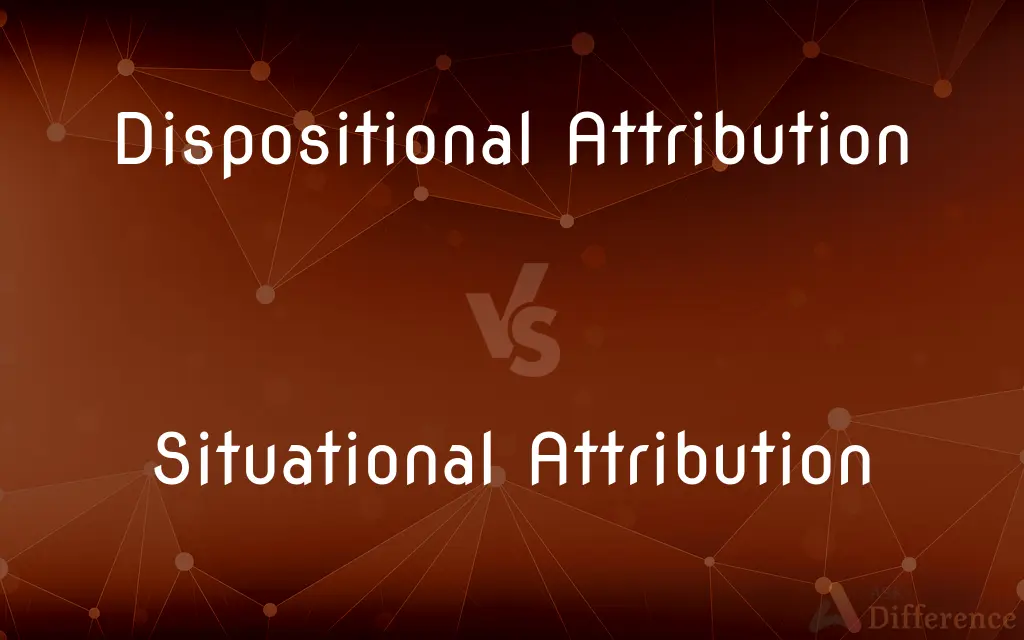Dispositional Attribution vs. Situational Attribution — What's the Difference?
By Tayyaba Rehman — Published on October 25, 2023
Dispositional Attribution ascribes behavior to internal traits; Situational Attribution attributes behavior to external circumstances.

Difference Between Dispositional Attribution and Situational Attribution
Table of Contents
ADVERTISEMENT
Key Differences
Dispositional Attribution refers to the tendency to attribute an individual's behavior to their inherent personality or character traits. It essentially implies that people act in certain ways because "that's just how they are." Situational Attribution, conversely, posits that an individual's behavior is largely influenced by external circumstances or situations.
In understanding someone's actions, Dispositional Attribution might suggest that a person behaved rudely because they are naturally impolite. On the flip side, Situational Attribution would argue that perhaps they acted that way due to a bad day at work or some external stressor.
Dispositional Attribution leans towards the belief that behaviors are stable and predictable based on an individual's disposition. Situational Attribution, meanwhile, emphasizes the role of external factors, believing that behaviors can vary significantly based on the context or environment.
One risk of Dispositional Attribution is the tendency to oversimplify and stereotype individuals based on perceived traits. Situational Attribution can prevent such stereotypes by considering the broader context, acknowledging that behaviors might be temporary and influenced by external variables.
Comparison Chart
Focus
Internal traits
External circumstances
ADVERTISEMENT
Basis for Behavior
"That's just how they are"
Behavior due to context or environment
Stability
Views behaviors as stable and predictable
Views behaviors as variable based on situations
Risk
Can lead to oversimplification and stereotyping
Might overlook consistent patterns in behavior
Behavioral Prediction
Believes behavior is consistent across situations
Believes behavior can change based on context
Compare with Definitions
Dispositional Attribution
Dispositional Attribution can lead to generalizations.
Relying heavily on Dispositional Attribution, she categorized him as introverted.
Situational Attribution
Situational Attribution focuses on external influences.
Her silence was a Situational Attribution, considering the unfamiliar group around.
Dispositional Attribution
Dispositional Attribution sees behavior as reflective of one's nature.
His kindness was seen as a Dispositional Attribution of his compassionate nature.
Situational Attribution
Situational Attribution sees behavior as a reaction to context.
The team's victory was a Situational Attribution, motivated by the home crowd.
Dispositional Attribution
Dispositional Attribution credits behavior to inherent personality traits.
She assumed his punctuality was due to his Dispositional Attribution of being organized.
Situational Attribution
Situational Attribution can overlook personal tendencies.
Citing only Situational Attribution, they missed her consistent tendency to avoid conflict.
Dispositional Attribution
Dispositional Attribution focuses on internal factors.
They believed his creativity was a Dispositional Attribution, not influenced by surroundings.
Situational Attribution
Situational Attribution attributes behavior to external circumstances.
His outburst was a result of Situational Attribution, perhaps due to work stress.
Dispositional Attribution
Dispositional Attribution implies consistent behavior across contexts.
Her assertiveness was a Dispositional Attribution, evident in various settings.
Situational Attribution
Situational Attribution implies behavior can vary by environment.
His excitement was a Situational Attribution, influenced by the surprise party.
Common Curiosities
Why might Dispositional Attribution lead to misunderstandings?
Relying solely on Dispositional Attribution might overlook external factors, leading to oversimplification or stereotypes.
Can both types of attributions be correct simultaneously?
Yes, behavior can be influenced by both internal traits (Dispositional Attribution) and external factors (Situational Attribution).
When might Situational Attribution be more accurate?
Situational Attribution might be more accurate when behavior is influenced by external events or conditions.
How do cultures influence these attributions?
Some cultures may lean towards Dispositional Attribution, while others might emphasize Situational Attribution more.
Which attribution type can contribute to the "Fundamental Attribution Error"?
Over-reliance on Dispositional Attribution, neglecting situational factors, leads to the Fundamental Attribution Error.
How do these attributions relate to self-perception?
Individuals may make Dispositional Attributions about their strengths and Situational Attributions for their failures, or vice versa.
How does Situational Attribution impact judgment?
Situational Attribution can foster empathy and understanding by recognizing the influence of context on behavior.
Can Situational Attribution be an excuse for consistent behavior?
While situations impact behavior, consistently attributing actions only to situations might overlook genuine dispositional tendencies.
Why is understanding these attributions important in communication?
Recognizing Dispositional vs. Situational Attribution helps in accurate assessments, fostering effective and empathetic communication.
Can Dispositional Attribution change over time?
While dispositional traits are relatively stable, personal growth and experiences can lead to changes.
How can one avoid making hasty Situational Attributions?
By seeking comprehensive information, reflecting, and avoiding generalizing based on limited data.
What does Dispositional Attribution reveal about a person?
Dispositional Attribution reveals perceived internal traits or characteristics driving a person's behavior.
How might businesses benefit from understanding these attributions?
Businesses can better manage and motivate employees by recognizing both dispositional traits and situational influences on performance.
Share Your Discovery

Previous Comparison
Spasticity vs. Rigidity
Next Comparison
Coupon Rate vs. Discount RateAuthor Spotlight
Written by
Tayyaba RehmanTayyaba Rehman is a distinguished writer, currently serving as a primary contributor to askdifference.com. As a researcher in semantics and etymology, Tayyaba's passion for the complexity of languages and their distinctions has found a perfect home on the platform. Tayyaba delves into the intricacies of language, distinguishing between commonly confused words and phrases, thereby providing clarity for readers worldwide.
















































